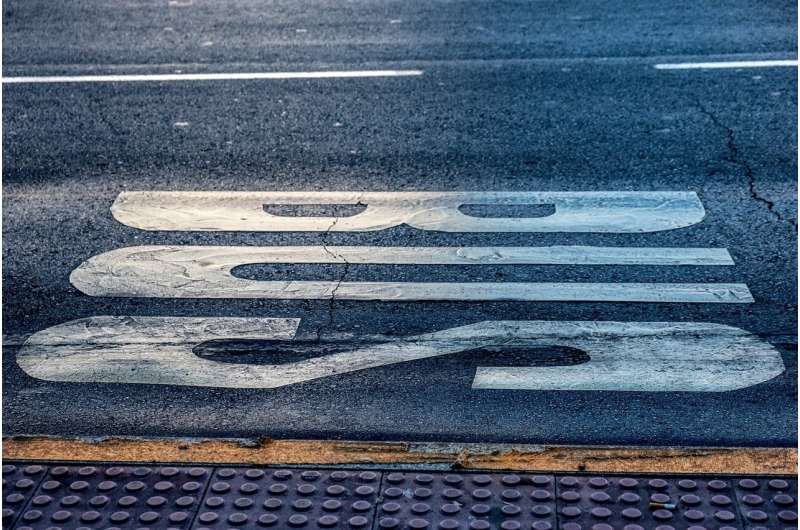 Credit: Pixabay/CC0 Public Domain
Credit: Pixabay/CC0 Public Domain
Bus transportation is an essential part of nearly every public transit system. From school students to everyday workers, riders depend on buses to transport them to the essential destinations. Because most passengers start or end their journey by walking, providing safe access to bus stops is key to enhancing pedestrian safety.
Pedestrian fatalities in the United States have significantly increased in recent years, with 2022 recording the most fatalities since 1981. While prior studies have analyzed bus stop safety using crash data, not all crashes near [bus stops](https://t…
 Credit: Pixabay/CC0 Public Domain
Credit: Pixabay/CC0 Public Domain
Bus transportation is an essential part of nearly every public transit system. From school students to everyday workers, riders depend on buses to transport them to the essential destinations. Because most passengers start or end their journey by walking, providing safe access to bus stops is key to enhancing pedestrian safety.
Pedestrian fatalities in the United States have significantly increased in recent years, with 2022 recording the most fatalities since 1981. While prior studies have analyzed bus stop safety using crash data, not all crashes near bus stops were directly related to the stop itself.
Candace Brakewood, an associate professor in the Department of Civil and Environmental Engineering, worked with Graduate Research Assistant Allison Rewalt and fellow CEE Professor Chris Cherry to address this gap by analyzing fatal transit bus stop-related pedestrian crashes from the Fatality Analysis Reporting System (FARS) and comparing them to other nearby fatal pedestrian crashes.
Their research, titled “An analysis of pedestrian safety at bus stops using FARS data,” was recently published in the Journal of Safety Research.
The research was funded through the Center for Pedestrian and Bicycle Safety(CPBS), which is a Tier I University Transportation Center (UTC) that is led by the University of New Mexico and includes UT, and a Dwight D. Eisenhower Graduate Fellowship that Rewalt received.
“Our work is unique because most prior studies used a more localized approach, relying on local or state crash data to understand the risks pedestrians face when walking to or from bus stops, whereas ours uses a national dataset to give us a bigger picture of what these risks look like nationwide,” Rewalt said. “Because our work is generalizable, it can be used to inform bus stop safety improvements across the country.”
Midblock stops present danger
The study uses pedestrian crash data that explicitly identifies bus stop-related crashes, providing a more nuanced assessment of crash risk factors for transit passengers and other pedestrians in the area, compared to previous studies that relied simply on proximity or other measures.
One of the key takeaways from the research is that there are three typical types of crashes that result in pedestrian fatalities at bus stops:
- pedestrians crossing to/from a bus stop at an intersection
- pedestrians waiting on the roadside at a midblock stop
- pedestrians crossing to/from a midblock stop.
Midblock stops are especially high risk, especially on high-speed arterials. Midblock locations increased the chances of a fatal crash by 4.7 to 5.2 times depending on the size of the buffer zone used in the analysis.
Pedestrians waiting on the roadside at a midblock stop is a crash subtype that is distinct to transit passengers, who often wait at the roadside for the bus to come, whereas other pedestrians would typically not be standing on the roadside for an extended period of time.
“This finding stood out because it points to a practical place to focus safety improvement near bus stops,” Rewalt said.
Finding infrastructure solutions
The UT researchers are hoping city planners, traffic engineers, and transit agencies can use their research findings to explore solutions to mitigate risk for pedestrians accessing buses. High-visibility crosswalks, especially at midblock crossings, or relocating bus stops closer to a signalized intersection could be infrastructure improvements to consider.
“We have an ongoing follow-up research project that continues to explore pedestrian safety at bus stops using a different nationwide dataset called CRSS that includes non-fatal crashes,” Brakewood said. “The overarching goal is to identify bus stop-related crash characteristics and determine which factors lead to more severe outcomes. We will have more results to share on the new project in the near future.”
Citation: Pedestrian deaths at midblock bus stops found to be up to 5 times higher (2025, October 25) retrieved 25 October 2025 from https://techxplore.com/news/2025-10-pedestrian-deaths-midblock-bus-higher.html
This document is subject to copyright. Apart from any fair dealing for the purpose of private study or research, no part may be reproduced without the written permission. The content is provided for information purposes only.